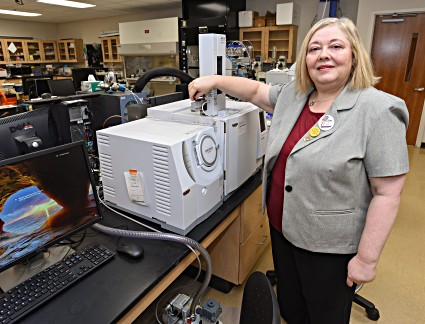
PRINCESS ANNE, MD- (July 7, 2021)-A University of Maryland Eastern Shore researcher and students from underrepresented minorities in STEM who are majoring in natural sciences will be tackling one of the U.S. Navy’s most costly problems –biofilm formation, or fouling. Biofilms, which lead to attachment of barnacles, cause millions of dollars of damage to naval ships and platforms each year and contribute to ecological changes with the potential to cause fish mortality and algal blooms.
The U.S. Navy has awarded Dr. Victoria Volkis, a professor of chemistry and director of UMES’ Master of Science Program, $1 million to study the use of natural plants for antifouling protection, under the “Sea platform environmental quality, corrosion control and advanced naval materials” field of interest. Not only will she serve as the principal investigator of a U.S. Navy Minority Serving Institution Program grant, she will also devote all of her academic time to the project as the recipient of a Distinguished Faculty Fellow award for the next three years.
“We will take nature as a template to study plants and algae high in antioxidants and encapsulated into different types of polymers as sources of novel anti-fouling agents,” Volkis said. “Take sea cucumbers, for instance. They never get coated by biofilm due to their ability to secrete natural bactericides.”
Natural remedies to the problem, she said, are necessary as tributyltin and other biocides in antifouling paints are banned in many countries, including the U.S., due to their high toxicity. Current alternative solutions are costly and focus on highly hydrophobic polymers, which do not offer effective control as they have difficulties with scaling up.
The goals of the project, she said, are to examine essential oils, terpenes and antioxidants from berries, leaves of specialty crops, medical herbs and algae (phytoextracts) for their antifouling properties. These compounds “have the ability to scavenger free radicals and kill bacteria.” Researchers will then develop procedures to encapsulate extracts into polymers, particularly with slow release capabilities. They will test samples and evaluate how different types and concentrations of extracts, polymers and other factors influence the quality and properties of antifouling formulations.
“We anticipate evaluating different species of super-fruits, berries and algae, several types of polar and non-polar solvents, along with traditional and biodegradable polymers to determine effective biofilm control formulations,” she said. “We will also take water samples from the Chesapeake Bay, Assawoman Bay and local rivers and ponds to evaluate how different marine environments influence the types of bacteria and intensity of growth during the biofilm formation process.”
Algae will be harvested, she said, using the UMES research vessel through the Paul S. Sarbanes Coastal Ecology Teaching and Research Center near Assateague, UMES’ dedicated marine field laboratory station. Water samples will be tested in the lab of collaborating UMES professor and Director of Research, Dr. Joseph Pitula. Dr. J. Sook Chung, a professor with the NOAA Living Marine Resources Cooperative Science Center at UMES, will provide models to study the toxicity of new formations at the Institute of Marine and Environmental Technology in Baltimore.
Volkis will also collaborate with agencies outside of UMES where students will do site visits to learn new research techniques. The Wye Research and Education Center in Queenstown, Maryland, will grow specialty crops and medicinal herbs such as aronia, goldenberry, hemp, hops and holy basil. Dr. Evgueni Nesterov in the Department of Chemistry and Biochemistry at Northern Illinois University will study surface characterization.
By the end of the three-year grant, Volkis, her colleagues and undergraduate and graduate students working in her organic chemistry research lab aim to have created antifouling formulations “that are non-toxic or have toxicity much lower than current biocides, are easy to manufacture and apply, and utilize organic renewable sources of materials.” In the process, Volkis said, students will have benefitted from participating in a high-tech interdisciplinary research program with real-life implications.
Two graduate students who are U.S. citizens will be hired for the duration of the grant from among the pool of applicants for UMES programs in toxicology, chemistry and marine-estuarine-and-environmental sciences. Preference, she said, will be given to students with interests in career pathways with the U.S. Navy or the Department of Defense. Each graduate student will have an undergraduate student working with them on a rotating basis who are U.S. citizens, have taken organic chemistry and have been selected based on GPA.
“They will leave UMES better prepared for scientific careers in STEM disciplines and for matriculation to postdoctoral and industrial positions,” Volkis said. “They will have also learned to work in an interdisciplinary environment having collaborated with science departments within and outside of UMES, university Extension outreach programs, farming communities and other stakeholders.”
“Dr. Volkis is one of the preeminent researchers at UMES. She has a strong track record of delivering both detailed and important research results and training the next generation of scientists from a minority-serving institution,” said Dr. Moses T. Kairo, dean, UMES School of Agricultural and Natural Sciences.
Gail Stephens, agricultural communications and media associate, University of Maryland Eastern Shore, School of Agricultural and Natural Sciences, gstephens@umes.edu, 410-621-3850.
Photos by Todd Dudek, agricultural commuincations photographer/videographer, University of Maryland Eastern Shore, School of Agricultural and Natural Sciences, tdudek@umes.edu.

